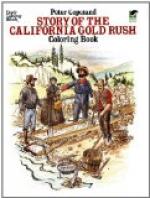The Indians Drake saw near Point Reyes had fur coats, or cloaks, but no other clothes. They brought him presents of shell money or wampum, and of feather head-dresses and baskets. With their bows and arrows they killed fish or deer or squirrels, and being very strong ran swiftly after game. They seemed gentle and peaceable with the white men and each other, and were sorry to have Drake sail away.
In later years the Indians who lived here when the Mission Padres came were stupid and brutish, because they knew nothing better. They were lazy, dirty, and at first would not work. But the patient Padres taught them to raise grain and fruit, to build their fine churches, to weave cloth and blankets, and to tan leather for shoes, saddles, or harness. But although the Indians learned to be good workmen, they liked idleness, dancing, and feasting much better, and when the Missions were given up the Indians soon went back to their former habits.
There were no distinct tribes among these Indians, and they had no laws. Nor was there a king or chief over many natives. They lived in small villages or rancherias, each having a name and ruled by a captain. Each rancheria had its special place to hunt or fish, and had to fight its own battles with the other families of Indians.
The men did nothing but hunt and fish, or make bows, stone arrow-heads, nets and traps for game. The women not only had to gather grass seeds, acorns, and nuts or berries, but they had to do all the field-work and carry the heavy burdens, usually with a baby strapped in its basket above the load. In preparing food for cooking, these mahalas, or squaws, put seed or acorns in a stone mortar and pounded them to coarse meal or paste. Sometimes a grass-woven basket was filled with water, and hot stones were thrown in till the water began to boil. Then acorn or seed meal was put in and cooked into mush. This meal, or that from wild oats, was also mixed into a dough and baked on hot stones into bread. Game or fish was eaten raw, or broiled a little on the coals of the camp-fire.
The Indians got many deer, and one way of hunting them was to put the head and hide of a deer over the hunter’s head. The make-believe then crept along in the high grass till near enough to the quietly feeding animals to put an arrow through one or more. All the streams were full of fish then, and salmon swarmed in rivers that ran to the ocean. These salmon the Indians speared or shot with arrows. They also built runways or fish-weirs and made them so that the fish would become crowded into a narrow passage, and could easily be dipped out with nets or baskets.
When the Americans came here they called these Indians “Diggers,” because they lived on what they could dig or root out of the ground. They were very fond of grasshoppers, and ate them either dried or raw, or made into a soup with acorn or nut-meal. Fat grubworms and the flesh of any animal found dead was a great treat. If a whale or sea-lion was washed ashore on the beach, the Indians gathered round it for a feast, and soon left only the bones.




